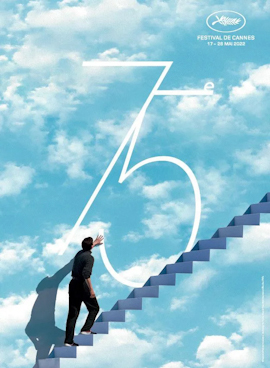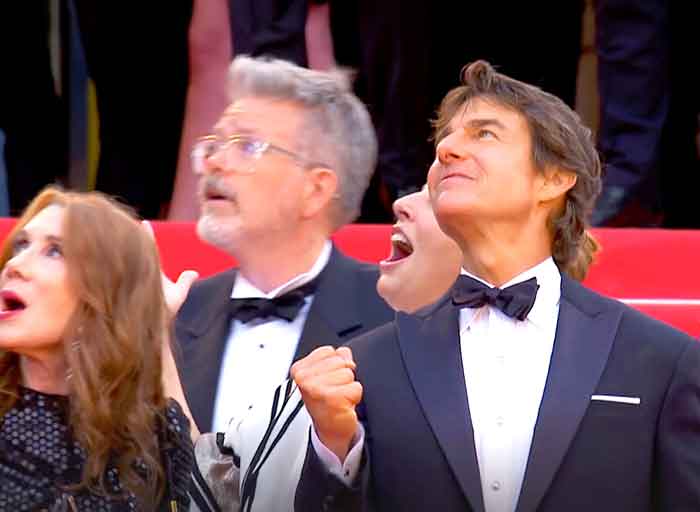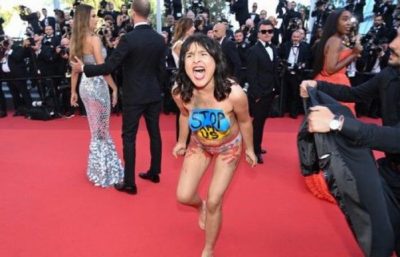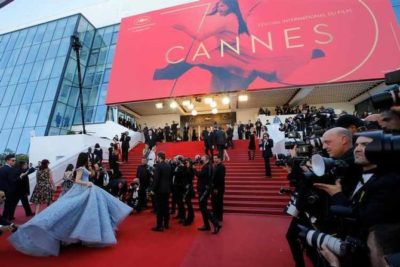 The 2022 Cannes Film Festival has just concluded, and based on what I’ve read it seems to have been largely uneventful (at least in comparison to past examples). The films on display (David Cronenberg’s CRIMES OF THE FUTURE and George Miller’s THREE THOUSAND YEARS OF LONGING aside) seemed uninspiring, and the behavior of the guests (the topless protester aside) disappointingly reserved.
The 2022 Cannes Film Festival has just concluded, and based on what I’ve read it seems to have been largely uneventful (at least in comparison to past examples). The films on display (David Cronenberg’s CRIMES OF THE FUTURE and George Miller’s THREE THOUSAND YEARS OF LONGING aside) seemed uninspiring, and the behavior of the guests (the topless protester aside) disappointingly reserved.
Cannes is to film festivals what the Oscars are to awards shows: the Giant Behemoth. Running for two weeks in May in the scenic French Riviera town of Cannes, with movie stars, directors, assorted tourists and several thousand media figures of various accreditation in attendance, the Cannes Film Festival is, in the words of the late William Goldman, “the biggest annual media event in the world” (as opposed to the Olympics and World Cup, which only occur every four years), and furthermore, “if you love film…Cannes, flanked by mountains, bordered by the sea, bathed from time to time in soft Mediterranean sun, surely is the last best place on Earth…”
“if you love film…Cannes, flanked by mountains, bordered by the sea, bathed from time to time in soft Mediterranean sun, surely is the last best place on Earth…”
That Cannes, for all its pretty scenery, is a wholly unremarkable environ outside the event was vital to the design of the festival’s head Gilles Jacob. His contention that it be the community’s only noteworthy occurrence has served the festival well (and is the reason the New York, Toronto and Venice film festivals don’t have the same prestige).
For film nerds, a knowledge of all things Cannes is essential, regardless of whether one has ever attended the festival. That means a ready grasp of words like Palais (Cannes’ major 2,400 seat theater), Marche rouge (the red carpet leading to the Palais) and Quinzaine des réalisateurs (or “Director’s Fortnight,” a festival instituted in 1968 to compete with Cannes, which has since appropriated it).
Screenings of in-competition films are shown at the Palais. The films’ stars and directors are seated in the auditorium’s center, and hit with spotlights when the movie ends, to applause that’s hopefully genuine (Cannes watchers tend to make a point of gauging the length of the applause, and if the audience stands, as in “CRIMES OF THE FUTURE got a six minute standing ovation.” The grand prize, the coveted Palm d’Or (Golden Palm), may have little cache at your local multiplex, but it’s a coveted acquisition in film nerd circles. The irony is that most directors and studios are afraid to send their films to Cannes due to the possibility that they won’t win the Palm d’Or and so go home looking like losers; as Jacob has stated, “Often when (the Hollywood studios) don’t know what to do with a movie, they’re happy to give it to us.”
Histrionic displays of camera-friendly ire (something woefully missing in 2022) are common at Cannes. Examples include the fracas initiated by filmmaker Carlos Saura, who in solidarity with the student protests that gripped France in May 1968 attempted to prevent his own film PEPPERMINT FRAPPE from premiering at Cannes by grabbing onto the curtain covering the Palais’ screen; the Italian iconoclast Carmelo Bene replying to a smart-assed journalist at a 1975 Cannes press conference with a curt “Fuck you”; a 1991 screening of the film ANNA KARAMAZOFF during which its star, Cannes darling Jeanne Moreau, telegraphed her feelings about it by chanting “merde!”; Sophie Marceau informing the 1999 awards ceremony audience that films are “merde” (that word again) and that “there are more important things, like sick children”; and Asia Argento reminding an auditorium-full of Cannes-goers in 2018 that for many decades the festival was a “hunting ground” for Harvey Weinstein.
solidarity with the student protests that gripped France in May 1968 attempted to prevent his own film PEPPERMINT FRAPPE from premiering at Cannes by grabbing onto the curtain covering the Palais’ screen; the Italian iconoclast Carmelo Bene replying to a smart-assed journalist at a 1975 Cannes press conference with a curt “Fuck you”; a 1991 screening of the film ANNA KARAMAZOFF during which its star, Cannes darling Jeanne Moreau, telegraphed her feelings about it by chanting “merde!”; Sophie Marceau informing the 1999 awards ceremony audience that films are “merde” (that word again) and that “there are more important things, like sick children”; and Asia Argento reminding an auditorium-full of Cannes-goers in 2018 that for many decades the festival was a “hunting ground” for Harvey Weinstein.
The Weinstein connection is a continual sore spot for Cannes. It’s no secret that for much of the nineties and aughts this notorious sex criminal functioned as, essentially, the English speaking world’s major conduit to the festival. Back in 1999 Jonathan Rosenbaum lamented the “apparent conviction of so many American “experts” in Cannes that foreign material is somehow contaminated unless it gets the Weinstein seal of approval,” and until a few years ago that was indeed the attitude among American film buffs—and probably still would be had Weinstein’s criminal activities not been exposed in 2016.
For those curious about the particulars of the event, much of the documentation consists of directors pimping their films (as in the New Zealand TV documentaries LOST IN THE GARDEN OF THE WORLD, 1975, and CANNES ‘92, 1992) and journalistic screeds. Examples of latter include the 1987 book TWO WEEKS IN THE MIDDAY SUN by Roger Ebert, the 1980 documentary BILLY BAXTER PRESENTS DIARY OF THE CANNES FILM FESTIVAL WITH REX REED, and the 2002 polemic MOVIE WARS by Jonathan Rosenbaum.

Ebert views the festival in a suitably affectionate manner, as a “Disneyland for adults.” Yet he also keeps an eye on the seamier side of Cannes, in which “local theaters grind away twenty hours a day with the interchangeable annual budget of exploitation pictures, a tribute to the industry’s unflagging optimism that new ways can be combined to combine tits, ass and machine guns.” TWO WEEKS IN THE MIDDAY SUN’S “hero” is the late Cannon Films honcho Menahem Golan, whose attempt at upgrading his schlockmeister image is applauded by Ebert (who was evidently unaware of the massive financial problems Cannon was facing).
Reed is more cynical, offering a tart dismissal of Cannes’ pretentions. Of the press conferences held by directors following the screenings of their films, he opines that “Every year they begin with the same question: ‘Why did you make this movie?’ I have yet to hear one director answer, ‘to make money.’” To illustrate this we’re shown a clip of Jean-Luc Godard offering a word stew of artistic gobbledygook in answer to that question (which saw its modern-day replay in 2022, when director James Grey responded to the query by offering up a Twitter-friendly rationale about “exposing white privilege”).
“Every year they begin with the same question: ‘Why did you make this movie?’ I have yet to hear one director answer, ‘to make money.’”
Rosenbaum, for his part, writes extensively, and despairingly, of his festival-going. His is the saltiest of the three viewpoints, accusing critics of having sold their souls to the Devil Weinstein and claiming that Cannes’ good old days, and those of most other film festivals the world over, are far in the past.
As for direct participants in Cannes, the documentation is considerably less voluminous, suggesting that the festival isn’t as exciting and glamorous as TWO WEEKS IN THE MIDDAY SUN makes it out to be. This is to say that Ebert’s description of how “At night, the elegant people emerge from their hotels, having spent the day playing tennis and lunching on yachts, and they stroll along the Boulevard Croisette in expensive formal wear, on their way to official black tie screenings,” probably isn’t entirely accurate (Martin Scorsese, in his introduction to the book, provides a world-weary rejoinder: “You go to the festival year after year, and you get to a point where could walk it in your sleep—in fact, that’s pretty much what you’re doing, because if you’re in Cannes, unless you’re French or Italian, you’re jet-lagged”).
Among the few extant texts by Cannes insiders are HYPE AND GLORY by William Goldman, about serving on the 1988 Cannes jury with a retinue that included Nastassja Kinski and George Miller. That entailed sitting through a lot of not-very-exciting art films, Luc Besson’s THE BIG BLUE and Krzysztof Kieslowski’s A SHORT FILM ABOUT KILLING among them. As for the awards selection, it occurred in a secluded mansion where Goldman and co. were locked in a room to engage in “over two hours of the most passionate movie talk I’ve ever been involved in” (for the record, PELLE THE CONQUEROR, Goldman’s favorite of the competing films, emerged the winner, narrowly beating out A WORLD APART).
Another interesting Cannes-related insider document is SEDUCED AND ABANDONED, from director James Toback and Alec Baldwin. Released in 2013, when these two men were still important players in the film world, this doco consists of Toback and Baldwin trying, without success, to find financing for a proposed low budget thriller to be headlined by Baldwin and Neve Campbell. SEDUCED AND ABANDONED is valuable for showing the business side of Cannes; to quote the aforementioned Rex Reed, “One of the main reasons people come to Cannes is to make deals. When the sun shines the Carlton Terrace is a cross between Wall Street and the Polo Lounge.”
Tangentially related to this topic is CHAMBRE 666, a 45 minute documentary by Germany’s Wim Wenders. Filmed in a hotel room adjacent to the 1982 Cannes Film Festival, it consists of 15 well-known filmmakers, including Jean-Luc Godard, Werner Herzog and Steven Spielberg, discussing their takes on the future of cinema, and how it jibes with commercial demands. Obviously the film is dated, and quite charmingly so given that back in ‘82 there was still a tug-of-war occurring between art and commerce; things are a bit different these days, and, given that the 2022 festival was dominated by the out-of-competition TOP GUN: MAVERICK and the fashions on display (Cannes having become second only to the Met Gala in the category of photogenic starlets showing off designer outfits), I’d say it’s pretty clear which side won out.



